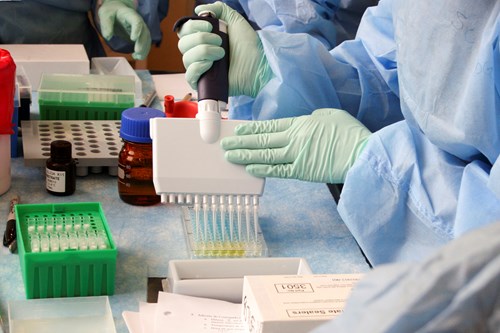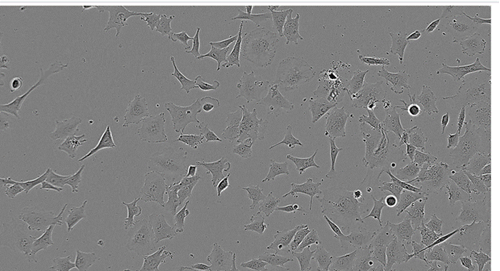Unique melanoma cell lines available from ECACC – The FM series

Melanoma (also called malignant melanoma) is a cancer that usually starts in the skin. It can start in a mole or in normal-looking skin.
Melanoma develops from cells called melanocytes that start to grow and divide more quickly than usual. It's important to find and treat melanoma as early as possible. Melanomas that are only in the upper layer of skin are unlikely to spread into the blood or lymphatic vessels. They are usually cured with surgery.
The FM series of melanoma cell lines was established from a metastatic cutaneous malignant melanoma of a male and female patients. This series are part of a collection representing more than 170 characterized melanoma cell lines collected during the ESTDAB project (European Searchable Tumour Line Database) part of the European Commission’s fifth framework infrastructures programme (contract no. QLRI-CT-2001-01325). ESTDAB (http://www.ebi.ac.uk/ipd/estdab) contains information on HLA genotype and surface expression of HLA molecules, expression of tumour antigens, antigen processing capability, production of and response to cytokines and chemokines, apoptosis regulation and expression of adhesion/accessory molecules. This information is appended below. Such information allows researchers to identify cells possessing specific parameters important for studies of immunity, immunogenetics, gene expression, metastasis, response to chemotherapy, and other tumour biological experimentation. Robinson J, Waller MJ, Fail SC, Marsh SG. 2006 The IMGT/HLA and IPD databases. Hum Mutat 27(12):11929.PMID: 16944494. Pawelec G, Marsh SG. 2006 ESTDAB: a collection of immunologically characterised melanoma cell lines and searchable databank. Cancer. Immunol Immunother. 55(6):623-7.PMID: 16421722. Robinson J, Roberts CH, Dodi IA, Madrigal JA, Pawelec G, Wedel L, Marsh SG.2009 The European searchable tumour line database. Cancer. Immunol 58(9):1501-6. PMID: 19172270.
FM-28 96 hours post seeding.

The FM series of melanoma cell lines available from ECACC
Cat.no. Cell line name Keywords
|
FM-28 |
Human melanoma, metastasis |
|
|
FM-3.13 |
Human melanoma, metastasis |
|
|
FM-3.26 |
Human melanoma, metastasis |
|
|
FM-3.29 |
Human melanoma, metastasis |
|
|
FM-45 |
Human melanoma, metastasis |
|
|
FM-55-M1 |
Human melanoma |
|
|
FM-55-M2 |
Human melanoma |
|
|
FM-55-P |
Human melanoma, primary tumour |
|
|
FM-55-p.R22.2 |
Human melanoma, HLA-A2 loss variant of FM-55-P |
|
|
FM-56 |
Human melanoma |
|
|
FM-6 |
Human melanoma, metastasis |
|
|
FM-70 |
Human melanoma, metastasis |
|
|
FM-72 |
Human melanoma, metastasis |
|
|
FM-74 |
Human melanoma, metastasis |
|
|
FM-79 |
Human melanoma, metastasis |
|
|
FM-81 |
Human melanoma, metastasis |
|
|
FM-82 |
Human melanoma, metastasis |
|
|
FM-88 |
Human melanoma, metastasis |
|
|
FM-92 |
Human melanoma |
|
|
FM-93/2 |
Human melanoma, metastasis |
|
|
FM-95 |
Human melanoma, metastasis |
|
|
FM3A |
Mouse C3H mammary carcinoma |
|
|
FM3Ats C1.T85 |
Mouse C3H mammary carcinoma |
Publications
- Kirkin A.F., Petersen T.R., Olsen A.C., Li L., thor Straten P., Zeuthen J. Generation of human-melanoma-specific T lymphocyte clones defining novel cytolytic targets with panels of newly established melanoma cell lines. Cancer Immunol. Immunother. 41:71-81(1995). PubMed=7656272; DOI=1007/BF01527402
- Kirkin A.F., thor Straten P., Zeuthen J. Differential modulation by interferon gamma of the sensitivity of human melanoma cells to cytolytic T cell clones that recognize differentiation or progression antigens. Cancer Immunol. Immunother. 42:203-212(1996). PubMed=8665567; DOI=1007/s002620050272
- Jonsson G., Dahl C., Staaf J., Sandberg T., Bendahl P.-O., Ringner M., Guldberg P., Borg A.
Genomic profiling of malignant melanoma using tiling-resolution arrayCGH. Oncogene 26:4738-4748(2007). PubMed=17260012; DOI=1038/sj.onc.1210252 - Rodriguez T., Mendez R., Roberts C.H., Ruiz-Cabello F., Dodi I.A., Lopez Nevot M.A., Paco L., Maleno I., Marsh S.G.E., Pawelec G., Garrido F.
High frequency of homozygosity of the HLA region in melanoma cell lines reveals a pattern compatible with extensive loss of heterozygosity. Cancer Immunol. Immunother. 54:141-148(2005). PubMed=15592718; DOI=1007/s00262-004-0561-5 - Dahl C., Christensen C., Jonsson G., Lorentzen A., Skjodt M.L., Borg A., Pawelec G., Guldberg P.
Mutual exclusivity analysis of genetic and epigenetic drivers in melanoma identifies a link between p14 ARF and RARbeta signaling. Mol. Cancer Res. 11:1166-1178(2013). PubMed=23851445; DOI=1158/1541-7786.MCR-13-0006 - Vogel C.J., Smit M.A., Maddalo G., Possik P.A., Sparidans R.W., van der Burg S.H., Verdegaal E.M.E., Heck A.J.R., Samatar A.A., Beijnen J.H., Altelaar A.F.M., Peeper D.S. Cooperative induction of apoptosis in NRAS mutant melanoma by inhibition of MEK and ROCK. Pigment Cell Melanoma Res. 28:307-317(2015). PubMed=25728708; DOI=1111/pcmr.12364
